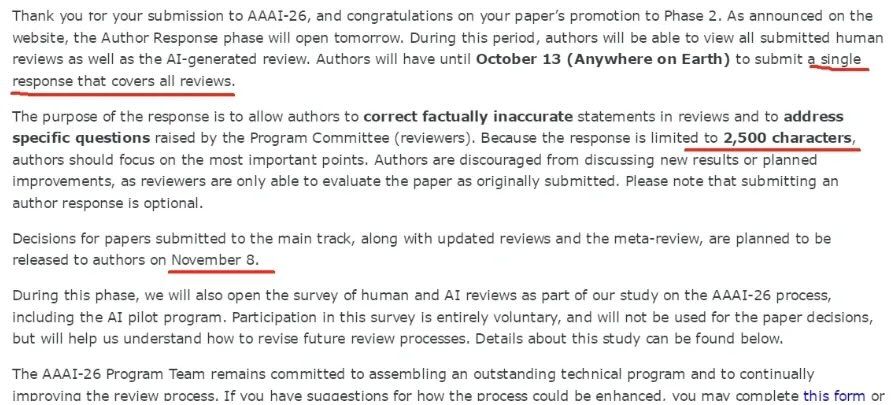🎉 AAAI 2026 Review Results & Rebuttal Phase — What You Need to Know!
-
After weeks of anticipation, the AAAI 2026 review results are finally out!
For many first-time submitters, this moment can be both exciting and nerve-wracking — should you rebut? Can a strong rebuttal really change the outcome? Let’s break it down.
🧾 Overview of the Review Phase
This year’s review results show a fairly concentrated distribution — most papers fall within the 5.0 to 5.8 range, representing the “upper-middle” zone.
Low-score papers (below 4.5) are rare, and a few standout submissions scored above 6, indicating strong potential.Interestingly, some manuscripts advanced to the second phase not due to high scores but because of insufficient or inconsistent reviewer feedback.
This highlights how much depends on your Area Chair (AC) — their judgment plays a crucial role.
🧠 The Rebuttal Strategy — 2500 Tokens of Power
Yes, the rebuttal this year is capped at 2500 tokens — that’s not much space! You need to be concise, factual, and persuasive.
 When You Must Rebut
When You Must Rebut- If you have one negative review and an average score below 5, you should definitely rebut.
- Address every key reviewer concern clearly and respectfully.
- Even if a reviewer’s confidence is high, it’s fine to politely disagree; just provide logical reasoning and evidence.
Remember: ACs look for professionalism, clarity, and whether your response genuinely resolves reviewers’ doubts.
 ️ How to Structure Your Rebuttal
️ How to Structure Your RebuttalBecause of the tight token limit, you need to maximize information density. Follow these principles:
-
Respond to all reviewers, not only the negative ones.
Positive reviewers deserve acknowledgment: it shows you respect their input. -
Prioritize manageable points.
Focus on those that can be convincingly clarified within the limit. -
Supplement experiments if absolutely necessary.
Although the format discourages adding new experiments, if multiple reviewers request it, include minimal yet meaningful results. -
Use tables where possible.
Tables take more characters but are easier for ACs to scan and evaluate; they improve clarity and signal transparency. -
Handle unreasonable comments diplomatically.
If a reviewer misunderstood your method, state it clearly and factually.
You can even quote positive remarks from other reviewers to balance perceptions. -
Highlight your contributions.
End your rebuttal by reinforcing the novelty, strengths, and impact of your work.
 Common Scenarios
Common Scenarios- Two or more negative reviews: Acceptance chances decrease, but rebutting can still help if issues are minor or based on misunderstandings.
- Three negatives: Consider revising and submitting to CVPR or another top venue after improving your paper.
If reviewers point out critical technical flaws, it might be better to revise thoroughly before the next submission.
 ️ Communicating with the AC
️ Communicating with the ACIn cases where you believe there was unfair or inconsistent reviewing, you can include a short note to the Senior Program Committee (SPC) highlighting potential issues.
Keep it factual — focus on clarifying misunderstandings and emphasizing your core contributions.Your goal: help the AC grasp your paper’s main story and rebuttal logic within one minute.
🧩 Final Tips
- Stay calm and objective. The AC will consider your tone and reasoning.
- Avoid emotional or defensive language — stick to facts.
- Make sure every claim in your rebuttal is verifiable and supported by data.
Even with limited space, sincerity and clarity can go a long way. Many papers with modest initial scores have made it through to acceptance thanks to a strong, respectful, and evidence-based rebuttal.
 Looking Ahead
Looking Ahead- AAAI 2026 Final Decision: November 8, 2025
- CVPR 2026 Abstract Deadline: November 6, 2025
If you’re considering a resubmission, it’s perfectly fine to prepare your CVPR abstract while working on the AAAI rebuttal — just in case.
Remember to complete all required fields truthfully to avoid desk rejections.
 Closing Words
Closing WordsRebuttal writing is not just about defending — it’s about communicating your work effectively.
Make your response logical, confident, and concise.
Let the AC see your dedication and clarity of thought.May your rebuttal be strong, your reviewers fair, and your paper — accepted with joy!

If you’d like to share your AAAI experience or seek feedback on your rebuttal draft, feel free to comment below!
